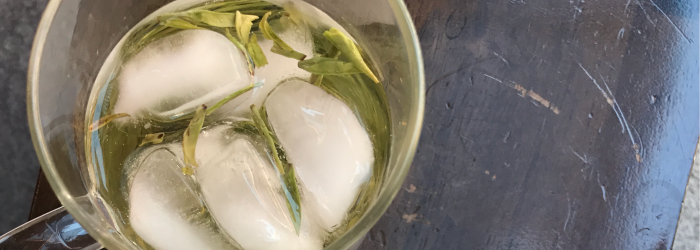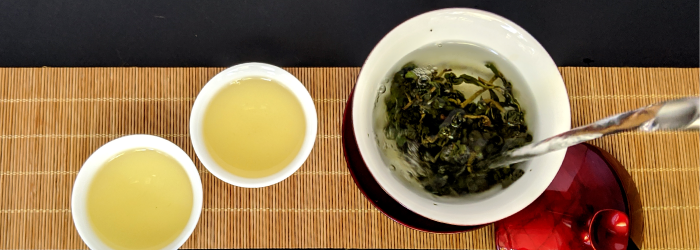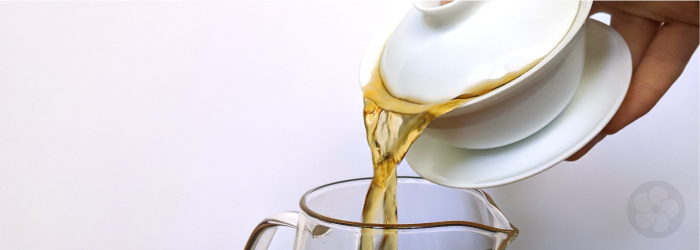How Cold Brewing Changes Tea Chemistry

It’s no secret that cold brewing is by far our favorite method of making iced tea. A long steep of natural teas in cold water creates flavor that is consistently sweet and smooth, negating the need for added flavors or sweeteners. Though hot tea holds an obvious place in our hearts, cold brews are the perfect way to create a refreshing, ice cold beverage with the full-bodied, complex flavors of our favorite single origin tea leaves.
Learn the simple method for making cold brew tea with Alice in this video:
We can admit that we have a few favorites for brewing this way, but the basic principle can be applied to any tea with similar results: a crisp, naturally sweet version of familiar flavors, often with an extra dimension of nuance in the finish. So why is this? How does cold water make such a difference in the way flavor is extracted from tea leaves? Today, we’re diving into the details.
Find five of our favorite teas to cold brew >>
How Brewing Works: Heat and Energy
To understand why cold brewing has such a distinct effect, it’s important to clarify how flavor is extracted from tea leaves in the first place. Dry tea leaves are composed of molecular solids, preserved by removing moisture during the crafting process. When water is reintroduced, some of these solids begin to dissolve, infusing the water with all the components that make up a great cup of tea.
Hot water does this quickly, because the water molecules are energized and moving quickly. When these energized molecules encounter tea leaves, they rapidly agitate the volatile solids of tea, causing more flavor molecules to dissolve in a shorter period of time. Cold water molecules, however, move more slowly, causing the infusion process to happen more gently over a longer period of time.
Learn how to balance water temperature and steeping time >>
Components of Flavor
Not all of the molecules in a tea leaf that create flavor dissolve at the same rate. The most interesting aspects of aroma and flavor come from so-called ‘volatile compounds’, a broad range of small molecules that occur in minor quantities and differ greatly between teas. Not surprisingly, these are called ‘volatile’ because they are among the first to be dissolved in water.
Next come carbohydrates and amino acids, the sources of natural sweetness, umami flavor, and rich textures. These molecules are still relatively small, and are fairly easy to extract from tea leaves. Young tea buds picked in spring are particularly rich in these compounds, which is why early harvests are commonly sought after.
Discover what makes some teas naturally sweet >>
Finally, the largest molecules include polyphenols, and methylxanthines like caffeine. These are among the last to be extracted, but the process can still happen very quickly when steeping with hot water. While these components may be motivating factors for some tea drinkers, they can also make the brew bitter and astringent when too many are extracted at once. This is why sippable water temperatures and short infusion times are usually recommended for the best flavor, even in hot brews.
Cold vs. Hot Water
Because cold water creates a slower, gentler extraction, the volatile aromatic compounds, carbohydrates, and amino acids make up the majority of extracted solids in the finished iced tea, while the larger molecules that create bitterness and astringency are drawn out at a lesser rate. This doesn’t necessarily mean that cold-brewed tea has fewer antioxidants, or less caffeine than a hot brew, but the ratio compared to extracted carbohydrates and amino acids is smaller, leaving the finished tea tasting sweeter and smoother than it’s hot-brewed counterpart.
Learn about the difference between bottled and freshly brewed iced tea >>
Of course, the ratios of these molecules can also vary from tea to tea: leaves grown with limited sun exposure in cooler climates with fewer insect predators generally contain more natural carbohydrates and amino acids. In contrast, fast-growing leaves grown in hot climates near sea level generally contain more of the compounds that cause bitterness and astringency. Cold brewing is not a magic bullet to make great tea from low quality leaves, but it can reveal new dimensions of flavor in well-crafted favorites.

The only trade-off is time: cold water requires about 3-5 hours to extract great flavor, while hot water can achieve extraction in less than a minute. Luckily, the gentler brewing process completely sidesteps the issue of over-brewing, so you can prepare a pitcher and leave it in the fridge overnight without sacrificing flavor quality. In fact, cold brewing might also be the easiest way to brew tea, without having to worry at all about precise water temperatures or steeping times.
Get started cold brewing with our all-inclusive kit >>
Have you tried cold brewing your favorite teas? Tell us about your experience in the comments below!
Sign up for our newsletter to get blog updates in your inbox!






Comments on this post (0)